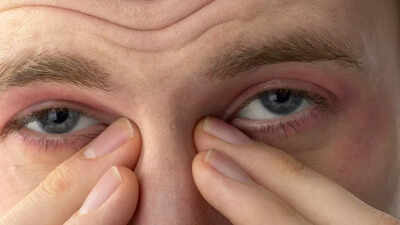Watery eyes, medically called epiphora, occur when the eyes produce excess tears or fail to drain properly. This common condition can affect one or both eyes and may develop at any age, though it is more frequent in newborns and older adults. Causes range from blocked tear ducts and allergies to eye infections, irritants, or nerve-related issues. While often not serious, watery eyes can be uncomfortable, cause blurred vision, and indicate underlying problems. Understanding the reasons for excessive tearing, along with home remedies and professional treatment options, can help manage symptoms and maintain eye health effectively.
Common causes of watery eyes
There are three main reasons why eyes may water excessively:
Blocked tear ducts
Tear ducts drain fluid from the eyes into the nose. If these ducts are blocked, narrow, or underdeveloped, tears may accumulate and overflow. According to a study published in NIH outlines how reflex tearing (especially from dry eye) is a major contributor to epiphora, and discusses the balance between tear production and drainage., In infants, congenital nasolacrimal duct obstruction (NLDO) is common, and most cases resolve by the first year. In adults, tear duct blockages can develop due to inflammation, scarring, or injury. Symptoms often include eye redness, swelling, crusting of eyelids, and blurred vision, which may worsen in cold or windy conditions.
Reflex tearing
This occurs when the eyes respond to irritation or environmental factors by producing extra tears. Common triggers include smoke, dust, wind, chemical fumes, or even cutting onions. Foreign objects like eyelashes or grit can also stimulate reflex tearing. Other causes include infections (such as conjunctivitis or keratitis), styes or chalazion, allergies, dry eyes, and conditions like ectropion (where the eyelid turns outward).
Excessive tear production
Rarely, watering eyes are caused by overactive tear production due to nerve dysfunction. Conditions like Bell’s palsy may lead to abnormal nerve regeneration, resulting in continuous tearing.
Home remedies to manage watery eyes
For mild or temporary cases of watery eyes, several home remedies can help relieve discomfort and support tear drainage:
- Take regular breaks from screens and reading: Prolonged screen time or close-up work can strain the eyes, leading to dryness that triggers reflex tearing. Following the 20-20-20 rule—looking at something 20 feet away every 20 minutes for 20 seconds—can reduce eye strain and limit excessive tearing.
- Use lubricating eye drops: Artificial tears or lubricating drops can help maintain moisture on the surface of the eye, preventing dryness-induced reflex tearing. These drops can also soothe irritation from dust, smoke, or wind.
- Apply a warm, damp cloth and gently massage the eyelids: Placing a warm compress over closed eyes for a few minutes can soften minor blockages in the tear ducts. Massaging the eyelids in gentle circular motions may help tears drain more efficiently and reduce overflow.
- Clean eyelids and lashes with an eye wipe: Removing debris, makeup, or dust from the eyelids and lashes prevents irritation that can trigger tearing. Using sterile eye wipes or a clean cotton pad with lukewarm water is effective and gentle.
- Use over-the-counter allergy medications if needed: If watery eyes are caused by allergic reactions, antihistamine eye drops or oral medications can reduce inflammation and tear production. Avoiding known allergens can also help prevent recurring episodes.
While these home remedies can provide relief and improve comfort, they are intended for mild cases. Persistent or worsening symptoms may indicate an underlying condition that requires professional evaluation and treatment.
Signs you should see a doctor for watery eyes
Seek medical attention if watery eyes are accompanied by:
- Changes in vision or sudden blurred vision
- Persistent pain, redness, or swelling
- Discharge or crusting around the eyes
- A feeling of a foreign object that does not go away
- Morning discomfort suggesting corneal issues or dryness
A doctor, usually an ophthalmologist or optometrist, can perform a thorough examination. They may check tear duct function, assess for infections or injuries, and identify structural problems like blockages or ectropion. Watery eyes can occur due to blocked tear ducts, reflex tearing from irritants, or, rarely, overactive tear production. While mild cases may improve with home remedies or simple observation, persistent symptoms, infections, or structural issues require professional care. Proper diagnosis ensures appropriate treatment, whether it’s medication, minor procedures, or surgery. By identifying the cause and following the right treatment approach, most people can relieve discomfort and maintain healthy, clear eyes.Disclaimer: This article is for general informational purposes only and is not a substitute for professional medical advice, diagnosis, or treatment. Always seek the guidance of a qualified healthcare provider regarding any medical condition or lifestyle change.Also Read: How poor sleep raises blood pressure: Protect your heart and lower stroke risk












